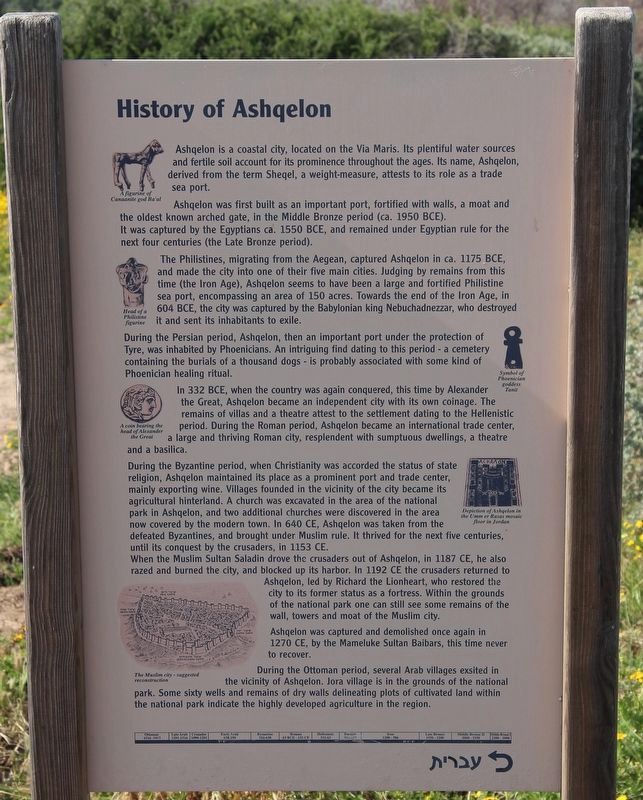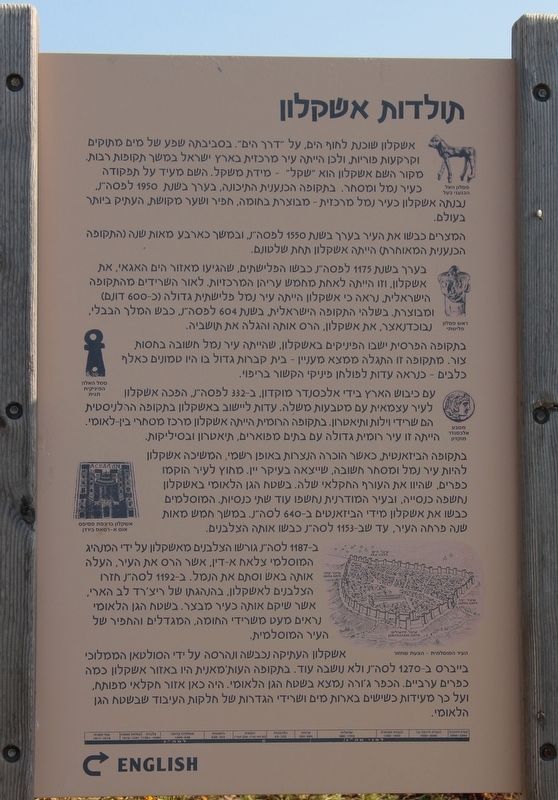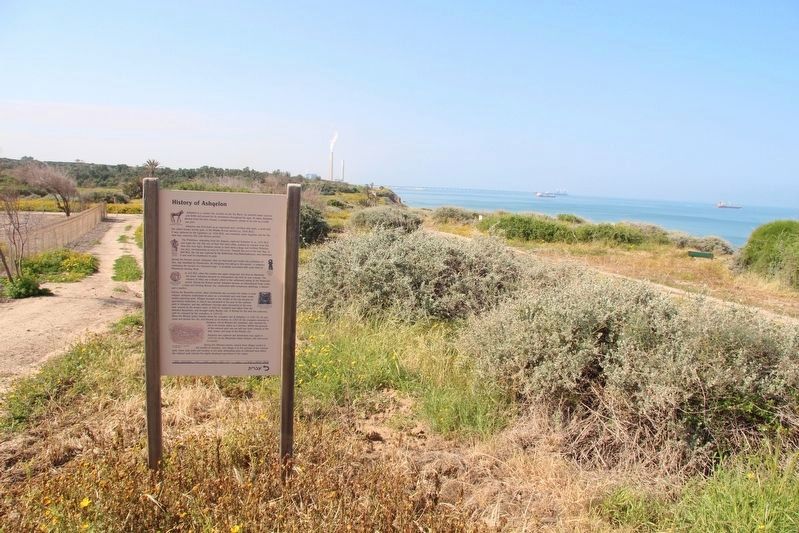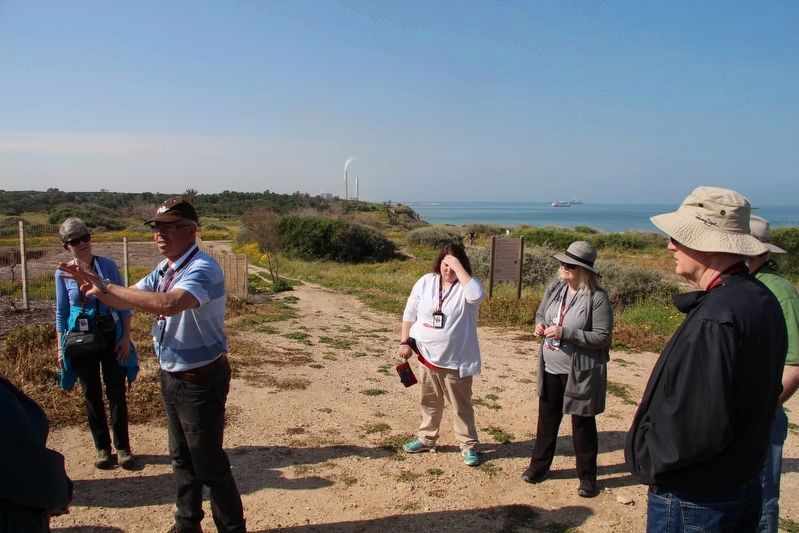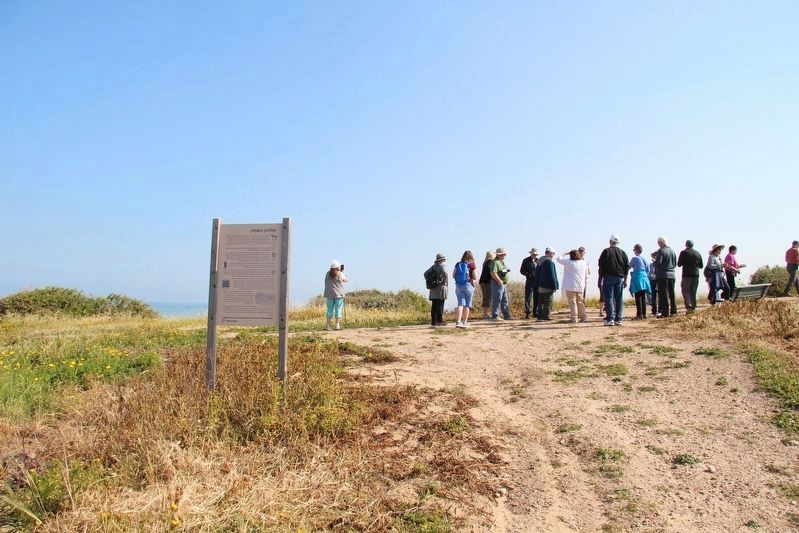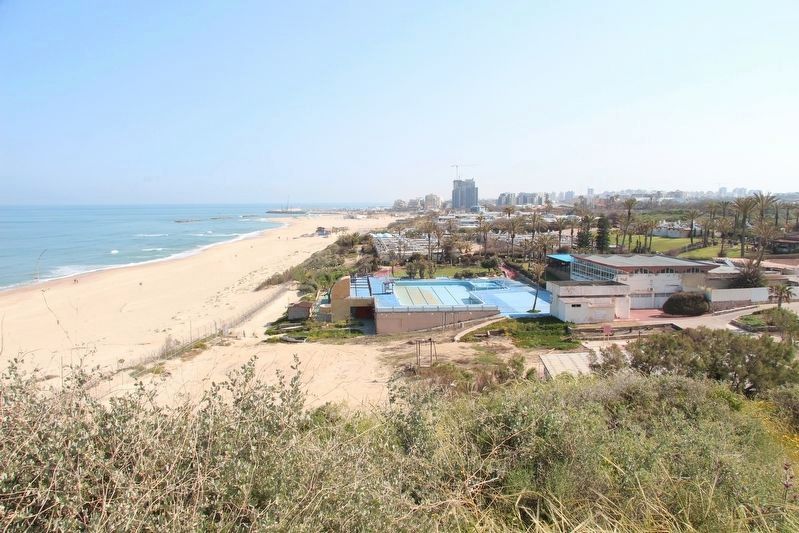Ashkelon, Southern District, Israel — West Asia (the Levant in the Middle East)
History of Ashqelon
Inscription.
Ashqelon is a coastal city, located on the Via Maris. Its plentiful water sources and fertile soil account for its prominence throughout the ages. Its name, Ashqelon, derived from the term Sheqel, a weight-measure, attests to its role as a trade sea port.
Ashqelon was first built as an important port, fortified with walls, a moat and the oldest know arched gate, in the Middle Bronze period (ca. 1950 BCE).
It was captured by the Egyptians ca. 1550 BCE, and remained under Egyptian rule for the next four centuries (the Late Bronze period).
The Philistines, migrating from the Aegean, captured Ashqelon in ca. 1175 BCE, and made the city into one of their five main cities. Judging by remains from this time (the Iron Age), Ashqelon seems to have been a large and fortified Philistine sea port, encompassing an area of 150 acres. Towards the end of the Iron Age, in 604 BCE, the city was captured by the Babylonian king Nebuchadnezzar, who destroyed it and sent its inhabitants to exile.
During the Persian period, Ashqelon, then an important port under the protection of Tyre, was inhabited by Phoenicians. An intriguing find dating to this period - a cemetery containing the burials of a thousand dogs - is probably associated with some kind of Phoenician healing ritual.
In 332 BCE, when the country was again conquered, this time by Alexander the Great, Ashqelon became an independent city with its own coinage. The remains of villas and a theatre attest to the settlement dating to the Hellenistic period. During the Roman period, Ashqelon became an international trade center, a large and thriving Roman city, resplendent with sumptuous dwellings, a theatre and a basilica.
During the Byzantine period, when Christianity was accorded the status of state religion, Ashqelon maintained its place as a prominent port and trade center, mainly exporting wine. Villages founded in the vicinity of the city became its agricultural hinterland. A church was excavated in the area of the national park in Ashqelon, and two additional churches were discovered in the area now covered by the modern town. In 640 CE, Ashqelon was taken from the defeated Byzantines, and brought under Muslim rule. It thrived for the next five centuries, until its conquest by the crusaders, in 1153 CE.
When the Muslim Sultan Saladin drove the crusaders out of Ashqelon, in 1187 CE, he also razed and burned the city, and blocked up its harbor. In 1192 CE the crusaders returned to Ashqelon, led by Richard the Lionheart, who restored the city to its former status as a fortress. Within the grounds of the national park one can see some remains of the wall, towers and moat of the Muslim city.
Ashqelon was
captured and demolished once again in 1270 CE, by the Mameluke Sultan Baibars, this time never to recover.
During the Ottoman period, several Arab villages exsited in the vicinity of Ashqelon. Jora village is in the grounds of the national park. Some sixty wells and remains of dry walls delineating plots of cultivated land within the national park indicate the highly developed agriculture in the region.
Topics. This historical marker is listed in these topic lists: Forts and Castles • Parks & Recreational Areas • Settlements & Settlers. A significant historical year for this entry is 1950.
Location. 31° 40.08′ N, 34° 32.902′ E. Marker is in Ashkelon, Southern District. Marker can be reached from T. Ben Amar Street just south of Sderot David Ben Gurion, on the right when traveling south. The marker is located in Ashkelon National Park, along a park walkway, on the ridge above, and to the west of, the Canaanite arched gateway entrance. Touch for map. Touch for directions.
Other nearby markers. At least 6 other markers are within 18 kilometers of this marker, measured as the crow flies. The Sanctuary of the Silver Calf (within shouting distance of this marker); The Canaanite City Gate (within shouting distance of this marker); The Canaanite Fortifications of Ashqelon (within shouting distance of this marker); Tel Ashqelon - the Canaanite City
(about 90 meters away, measured in a direct line); Remains of the Muslim City (about 120 meters away); The Day that Saved Israel (approx. 17.1 kilometers away).
More about this marker. In 2019, because I traveled to Israel as part of a tour group, taking pictures of historical markers and recording location information for each marker that I photographed was a difficult assignment. Then too, having two bad knees and walking with a cane made keeping up with my tour group, much less recording location information as well, even more difficult. So I am using my Google Map skills, from at home, to provide the needed location information and map coordinates. Anyone that visits these markers is welcomed, and encouraged, to improve on the provided information.
Also see . . .
1. Tel Ashkelon - BibleWalks.com. This is a link to additional information regarding this marker. (Submitted on April 20, 2019, by Dale K. Benington of Toledo, Ohio.)
2. Ashkelon (BiblePlaces.com). This is a link to additional information regarding this marker. (Submitted on April 20, 2019, by Dale K. Benington of Toledo, Ohio.)
3. Ashkelon National Park - Wikipedia. This is a link to additional information regarding this
marker. (Submitted on April 20, 2019, by Dale K. Benington of Toledo, Ohio.)
4. Ashkelon & Surroundings - Jewish Virtual Library. This is a link to additional information regarding this marker. (Submitted on April 20, 2019, by Dale K. Benington of Toledo, Ohio.)
Credits. This page was last revised on April 20, 2019. It was originally submitted on April 19, 2019, by Dale K. Benington of Toledo, Ohio. This page has been viewed 175 times since then and 3 times this year. Photos: 1, 2, 3, 4, 5, 6. submitted on April 19, 2019, by Dale K. Benington of Toledo, Ohio.
